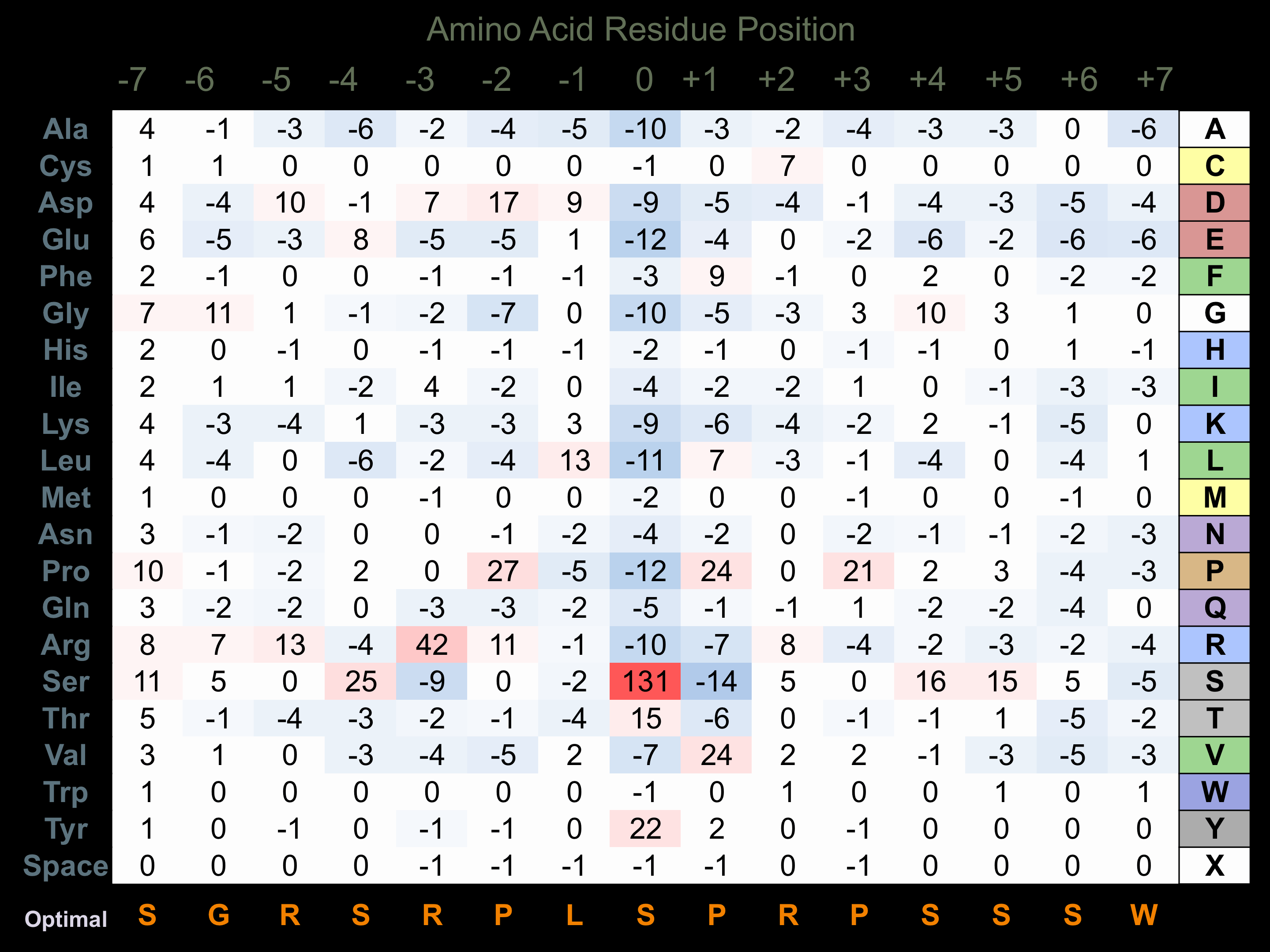Nomenclature
Short Name:
TLK2
Full Name:
Serine-threonine-protein kinase tousled-like 2
Alias:
- EC 2.7.11.1
- MGC44450
- PKU-alpha
- Tousled-like kinase 2
Classification
Type:
Protein-serine/threonine kinase
Group:
Other
Family:
TLK
SubFamily:
NA
Structure
Mol. Mass (Da):
87,661
# Amino Acids:
772
# mRNA Isoforms:
3
mRNA Isoforms:
87,661 Da (772 AA; Q86UE8); 85,444 Da (750 AA; Q86UE8-2); 82,348 Da (718 AA; Q86UE8-3)
4D Structure:
Heterodimerizes with TLK1. Interacts with ASF1A and ASF1B.
1D Structure:
Subfamily Alignment

Domain Distribution:
| Start | End | Domain |
|---|---|---|
| 225 | 276 | Coiled-coil |
| 317 | 347 | Coiled-coil |
| 403 | 451 | Coiled-coil |
| 462 | 741 | Pkinase |
Post-translation Modifications
For detailed information on phosphorylation of this kinase go to PhosphoNET
Serine phosphorylated:
S7, S26, S34, S35, S38, S41, S44, S46, S73, S94, S99, S103, S110, S111, S115, S117, S134, S177, S182, S185, S223, S617, S686, S753, S761, S769, S771.
Threonine phosphorylated:
T52, T72, T78, T98, T300, T695.
Tyrosine phosphorylated:
Y70, Y259, Y724.
Ubiquitinated:
K156.
Distribution
Based on gene microarray analysis from the NCBI
Human Tissue Distribution
% Max Expression:
Mean Expression:
Number of Samples:
Standard Deviation:
% Max Expression:
Mean Expression:
Number of Samples:
Standard Deviation:
 69
69
1109
41
925
 11
11
184
19
337
 8
8
130
2
55
 19
19
301
135
447
 43
43
697
43
569
 6
6
95
96
122
 11
11
175
51
421
 62
62
1006
34
1478
 30
30
488
17
407
 6
6
104
125
226
 6
6
101
24
89
 49
49
794
179
627
 7
7
117
26
69
 14
14
223
14
289
 8
8
133
19
155
 7
7
108
27
117
 19
19
304
200
1663
 10
10
156
13
280
 11
11
183
115
437
 36
36
587
167
582
 12
12
189
17
168
 9
9
149
19
133
 9
9
149
12
60
 27
27
435
15
354
 16
16
253
17
259
 45
45
730
82
621
 8
8
136
29
109
 11
11
172
13
205
 10
10
169
13
102
 7
7
117
56
110
 49
49
794
24
667
 100
100
1612
48
3327
 8
8
131
93
388
 52
52
840
109
703
 49
49
787
61
1070
Evolution
Species Conservation
PhosphoNET % Identity:
PhosphoNET % Similarity:
Homologene %
Identity:
PhosphoNET % Identity:
PhosphoNET % Similarity:
Homologene %
Identity:
 100
100
100
100 88.3
88.3
88.3
100 82.4
82.4
83
98 -
-
-
99.5 -
-
-
99 81.3
81.3
81.4
99.5 92.5
92.5
92.8
- 92.5
92.5
92.8
99 -
-
-
99.5 -
-
-
- 68.7
68.7
77.7
- 94.2
94.2
95.8
97 78
78
83.9
95 78
78
83.9
86 -
-
-
- -
-
-
64 36.6
36.6
50.2
- 36.6
36.6
50.2
52 -
-
-
- -
-
-
- -
-
-
- 35.4
35.4
50.3
- 35.4
35.4
50.3
- -
-
-
- -
-
-
-
For a wider analysis go to PhosphoNET Evolution in PhosphoNET
Binding Proteins
Examples of known interacting proteins
hiddentext
| No. | Name – UniProt ID |
|---|---|
| 1 | ASF1B - Q9NVP2 |
| 2 | YWHAZ - P63104 |
| 3 | TLK1 - Q9UKI8 |
| 4 | MBP - P02686 |
| 5 | ASF1A - Q9Y294 |
| 6 | FEZ1 - Q99689 |
Regulation
Activation:
NA
Inhibition:
Inactivated by phosphorylation at Ser-750, potentially by CHK1.
Synthesis:
NA
Degradation:
NA
Protein Kinase Specificity
Matrix of observed frequency (%) of amino acids in aligned protein substrate phosphosites

Matrix Type:
Predicted from the application of the Kinexus Kinase Substrate Predictor Version 2.0 algorithm, which was trained with over 10,000 kinase-protein substrate pairs and 8,000 kinase-peptide substrate pairs.
Domain #:
1
Inhibitors
For further details on these inhibitors click on the Compound Name and enter it into DrugKiNET or click on the ID's
Based on in vitro and/or in vivo phosphorylation data
| Compound Name | KD, Ki or IC50 (nM) | PubChem ID | ChEMBL ID | PubMed ID |
|---|
Disease Linkage
Comments:
TLK2 levels are more than 2-fold higher in up-regulation in human cancers than most protein kinases. The D613A in TLK2 is associated with loss of kinase activity. Gene variations in the amplicon may associate with increased breast cancer risk.
Gene Expression in Cancers:
TranscriptoNET (www.transcriptonet.ca) analysis with mRNA expression data retrieved from the National Center for Biotechnology Information's Gene Expression Omnibus (GEO) database, which was normalized against 60 abundantly and commonly found proteins, indicated altered expression for this protein kinase as shown here as the percent change from normal tissue controls (%CFC) as supported with the Student T-test in the following types of human cancers: Brain glioblastomas (%CFC= +347, p<0.005); Cervical cancer stage 2B (%CFC= -70, p<0.04); Clear cell renal cell carcinomas (cRCC) stage I (%CFC= -68, p<0.0001); Oral squamous cell carcinomas (OSCC) (%CFC= +49, p<0.003); Prostate cancer - primary (%CFC= -79, p<0.0001). The COSMIC website notes an up-regulated expression score for TLK2 in diverse human cancers of 1020, which is 2.2-fold of the average score of 462 for the human protein kinases. The down-regulated expression score of 287 for this protein kinase in human cancers was 4.8-fold of the average score of 60 for the human protein kinases.
Mutagenesis Experiments:
Insertional mutagenesis studies in mice support a role for this protein kinase in mouse cancer oncogenesis.
Mutation Rate in All Cancers:
Percent mutation rates per 100 amino acids length in human cancers: 0.07 % in 24926 diverse cancer specimens. This rate is only -7 % lower and is very similar to the average rate of 0.075 % calculated for human protein kinases in general.
Mutation Rate in Specific Cancers:
Highest percent mutation rates per 100 amino acids length in human cancers: 0.39 % in 603 endometrium cancers tested; 0.33 % in 864 skin cancers tested; 0.24 % in 589 stomach cancers tested; 0.2 % in 1271 large intestine cancers tested; 0.19 % in 273 cervix cancers tested; 0.17 % in 548 urinary tract cancers tested; 0.09 % in 1636 lung cancers tested; 0.08 % in 1512 liver cancers tested; 0.07 % in 710 oesophagus cancers tested; 0.05 % in 1459 pancreas cancers tested; 0.05 % in 1448 kidney cancers tested; 0.05 % in 1316 breast cancers tested; 0.03 % in 881 prostate cancers tested; 0.03 % in 382 soft tissue cancers tested; 0.02 % in 2082 central nervous system cancers tested; 0.01 % in 958 upper aerodigestive tract cancers tested; 0.01 % in 2009 haematopoietic and lymphoid cancers tested.
Frequency of Mutated Sites:
Most frequent mutations with the number of reports indicated in brackets: R262Q (8); R262* (2); T435M (3).
Comments:
Only 2 deletions, and no insertions or complex mutations are noted on the COSMIC website. About 39% of the point mutations are silent and do not change the amino acid sequence of the protein kinase.

